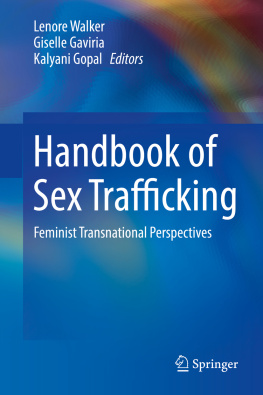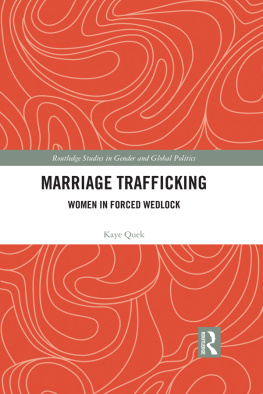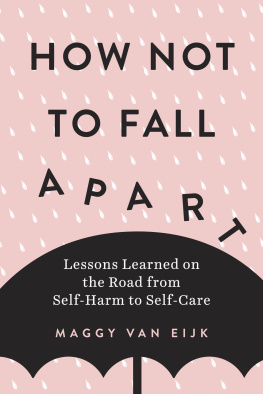TRAFFICKING AND
GLOBAL CRIME CONTROL
TRAFFICKING AND
GLOBAL CRIME CONTROL
MAGGY LEE
Maggy Lee 2011
First published 2011
Apart from any fair dealing for the purposes of research or private study, or criticism or review, as permitted under the Copyright, Designs and Patents Act, 1988, this publication may be reproduced, stored or transmitted in any form, or by any means, only with the prior permission in writing of the publishers, or in the case of reprographic reproduction, in accordance with the terms of licences issued by the Copyright Licensing Agency. Enquiries concerning reproduction outside those terms should be sent to the publishers.
SAGE Publications Ltd
1 Olivers Yard
55 City Road
London EC1Y 1S
SAGE Publications Inc.
2455 Teller Road
Thousand Oaks, California 91320
SAGE Publications India Pvt Ltd
B 1/I 1 Mohan Cooperative Industrial Area
Mathura Road
New Delhi 110 044
SAGE Publications Asia-Pacific Pte Ltd
33 Pekin Street #02-01
Far East Square
Singapore 048763
Library of Congress Control Number Available
British Library Cataloguing in Publication data
A catalogue record for this book is available from the British Library
ISBN 978-1-4129-3556-2
ISBN 978-1-4129-3557-9 (pbk)
Typeset by C&M Digitals (P) Ltd, Chennai, India
Printed by CPI Antony Rowe, Chippenham, Wiltshire
Printed on paper from sustainable resources
Contents
Acknowledgements
This book was made possible by the help and support of a number of people. I would like to thank the reviewers who provided useful suggestions and encouraging remarks about the original proposal and draft manuscript, and the Home Office, UNESCO and UNODC for permission to reproduce figures. I am also grateful to Caroline Porter and Sarah-Jayne Boyd at Sage for their enthusiasm in the book project and for guiding the manuscript through to publication with much patience, skill and good humour.
The Departments of Sociology at the University of Hong Kong and University of Essex have provided an intellectually stimulating and convivial environment in which to pursue this book project. Some of the background research was facilitated by grants from the British Academy and the University of Hong Kong Seed Funding Programme. Colleagues and friends have encouraged and advised me and read draft chapters during the course of preparing this book. I am particularly grateful to Eugene McLaughlin, Loraine Gelsthorpe, Maurice Punch, Mary Bosworth, Richard Miles, Sharon Pickering, Lydia Morris, Darren Thiel, Rob Stones, Karen Joe Laidler, Borge Bakken, and Thomas Wong. Finally, special thanks to Chris for adopting Hong Kong as his home, and to my siblings and nieces and nephew for the photography outings and many other family distractions.
Acronyms
CEDAW | Convention on the Elimination of All Forms of Discrimination Against Women |
EC | European Commission |
EU | European Union |
EUROPOL | European Police Office |
GAATW | Global Alliance Against Trafficking in Women |
ILO | International Labour Organisation |
INTERPOL | International Criminal Police Organisation |
IOM | International Organisation for Migration |
NATO | North Atlantic Treaty Organisation |
NGO | Non-Governmental Organisation |
SOCA | Serious Organised Crime Agency |
TIP Report | Trafficking in Persons Report (US) |
UKHTC | United Kingdom Human Trafficking Centre |
UNDP | United Nations Development Programme |
UNICEF | United Nations Childrens Fund |
UNIFEM | United Nations Development Fund for Women |
UNODC | United Nations Office on Drugs and Crime |
UNOHCHR | United Nations Office of the High Commissioner for Human Rights |
WHO | World Health Organisation |
Introduction
The trafficking of human beings has attracted considerable public and political concern at national and global levels in recent years. The problem of trafficking typically conjures up images of vulnerable women and children being traded by all-pervasive organised crime networks and unscrupulous snakeheads for sex or cheap labour around the world. It has been variously referred to as the dark side of globalisation (Ministerial Conference of the G-8 Countries on Combating Transnational Organized Crime, 1999), a threat to the human rights and the fundamental values of democratic societies (Council of Europe, 2005), and nothing less than modern day slavery (Blair, 2006; US Department of State, 2007).
Trafficking is nothing new. It has been described as a form of trade that is as old as trade itself (Andreas, 1998), even though there is significant diversity in what is trafficked, what trade is prohibited, and by whom over time. Human trafficking has historical parallels with the traffic in and exploitation of black Africans in previous centuries, when the colonial slave trade was considered not only a lawful but desirable branch of commerce by European empires. Today, human trafficking has become the subject of much empirical research, academic debate and advocacy in diverse disciplines and fields such as criminology, politics, law, human rights, sociologies of migration, gender, and public health. Global and regional responses to the problem have been phenomenal, so much so that trafficking has arguably been transformed from a poorly funded, NGO womens issue in the early 1980s into the global agenda of high politics of the United States Congress, the European Union, and the United Nations (Wong, 2005: 69). According to one estimate, there were over 30 intergovernmental bodies in Europe alone focusing on human trafficking and smuggling by the late 1990s (Morrison, 2000).
Yet there remain considerable gaps and limitations in our knowledge and understanding of human trafficking. The trafficking debate has been criticised by some for its shoddy research, anecdotal information, or strong moralistic positions (Sanghera, 2005). Popular assertions by some politicians, bureaucrats and lobbyists that human trafficking is growing at an alarming rate do not always hold up to careful scrutiny. Instead, global estimates of rising figures of trafficked victims and value of the human trafficking industry have been criticised as being based on slippery statistics and sliding definitions (Murray, 1998; Chapkis, 2003). Further, counter-trafficking programmes and policy measures tend to reflect conflicting agendas and a lack of political will arising from unspoken biases and confusion over the issue. While there is obvious concern to protect victims and to prevent a range of trafficking harms, states have also been criticised for conflating anti-trafficking with immigration and asylum controls (Green and Grewcock, 2002; Pickering, 2004). Many of the counter-trafficking measures and border controls that have emerged alongside the (re)discovery of the trafficking problem have been contentious, arguably pushing a larger proportion of unauthorised and forced migrants into the hands of professional smugglers or traffickers, exposing trafficked persons to greater danger than would otherwise have been the case, making limited impact on the social causes of trafficking, and generating dire consequences for those migrants who are on the move (Morrison, 2000; Oxfam, 2005; United Nations Economic and Social Council, 2006).









![Reichel - Global Crime: an Encyclopedia of Cyber Theft, Weapons Sales, and Other Illegal Activities [2 Volumes]](/uploads/posts/book/262750/thumbs/reichel-global-crime-an-encyclopedia-of-cyber.jpg)
